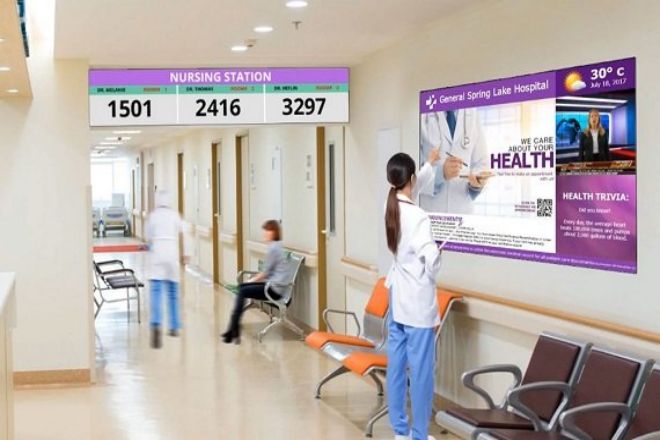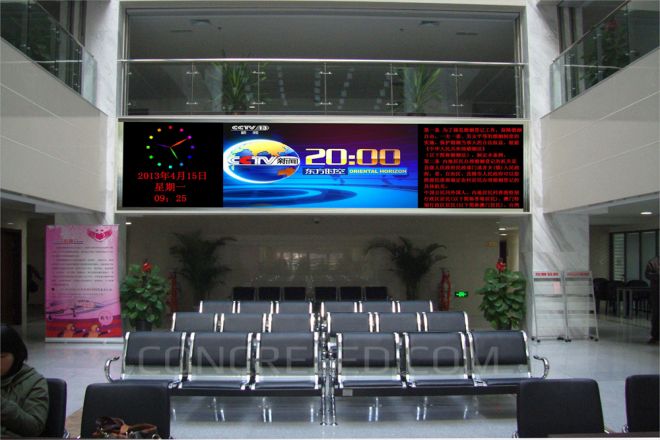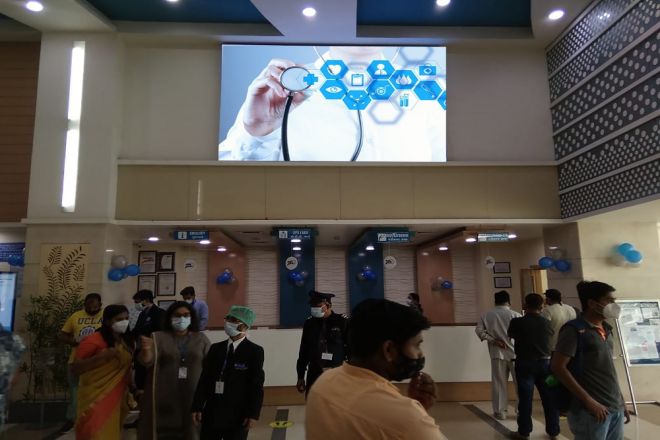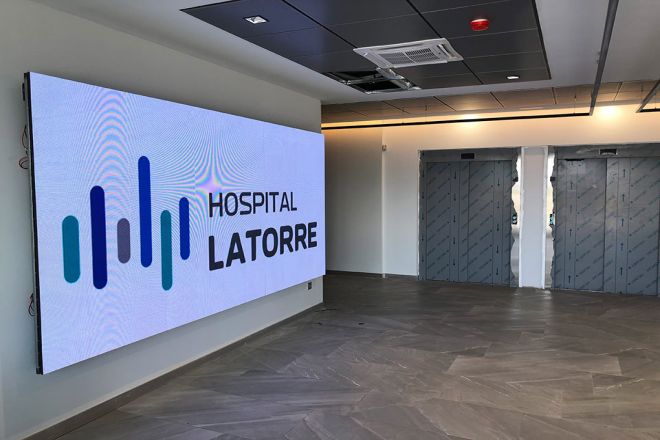序章

LED表示画面 have been widely used in various fields due to their characteristics. Especially in the medical field, hospital LED display screens, as an efficient information dissemination and public communication tool, have become an indispensable part of modern hospitals.
Now, when we enter the hospital, the first thing we see is a huge LED display. So why do hospitals need to use LED displays? Which places need to install LED displays? Let’s take a look.
1. Why do hospitals need LED displays?
The use of LED displays in hospitals has brought many benefits, which are reflected not only in the improvement of hospital operational efficiency but also in the improvement of patient experience and the effective dissemination of medical information.
- Information is clear and accessible quickly.
Have you ever been lost in the hospital and didn’t know where to find the department or doctor? The hospital LED display screen is like a large electronic sign that can clearly tell you the location of each department, the doctor’s schedule, and even your registration and test results. This way, you no longer have to run around looking for information.
- Create a comfortable environment and relieve tension.
For patients, LED displays not only provide a clear and intuitive channel for obtaining information but can also relieve their nervousness and improve their medical experience by playing soothing music and displaying beautiful pictures. At the same time, the LED display can also play health knowledge videos to help patients better understand their condition and treatment methods, thereby enhancing their health awareness.
Hospitals often give people a tense and serious feeling. But the LED display can play some relaxing music or natural scenery, making you feel as comfortable as at home. Such an environment can help relieve your tension and make you more relaxed for treatment.
- Keep abreast of hospital news and maintain communication with the hospital.
Hospital LED displays can serve as an important platform for doctor-patient communication. By publishing hospital notices, announcements, and other information, transparency between doctors and patients can be increased, and misunderstandings and disputes reduced.
At the same time, the LED display can also display the hospital’s culture, activities, and other information to enhance patients’ sense of identity and trust in the hospital.
For example, temporary adjustments to working hours, new medical services, etc. The LED display screen can update this information in real-time, ensuring that you are always aware of the latest developments in the hospital. This way, you can better communicate with the hospital and not miss any important information.
- Respond to emergencies and ensure safety.
If an emergency occurs in the hospital, such as a fire or earthquake, the LED display can quickly display evacuation routes and rescue information. In this way, you can find a safe exit in the shortest time and ensure your own safety.
2. The performance that LED display screens used in hospitals must possess

High definition and rich colors: LED displays must be able to display clear, detailed images and colors to ensure the accurate communication of medical information. This is critical for both patients and healthcare professionals, who rely on this information for decision-making and operations.
High grayscale representation: In the medical field, grayscale representation is very important for image clarity and contrast. LED displays used in hospitals should have high grayscale capabilities to achieve better results in displaying dark details.
Durability and stability: Hospital environments usually have high requirements for equipment, so LED displays need to have high durability and stability. This includes characteristics such as being able to work continuously for a long time, resisting harsh environments (such as high temperature, high humidity, etc.), and preventing electrostatic failure.
Low energy consumption: In order to respond to environmental protection and energy-saving requirements, LED displays used in hospitals should have low energy consumption. This not only reduces the negative impact on the environment but also reduces the hospital’s operating costs.
Good display effect consistency: When multiple LED displays work at the same time, the display effects between them should be consistent to ensure accurate communication of information and overall aesthetics.
High-precision pixel and color correction: The medical field has high requirements for image and color accuracy, so LED displays need to have high-precision pixel and color correction functions to ensure the accuracy of displayed content.
Powerful receiving card function: The receiving card is an important part of the LED display screen and needs to integrate HUB75 and support conventional chips to achieve high refresh, high grayscale, high brightness, and other functions. In addition, the receiving card should also support a large load area, have professional calibration functions, and support cloud backup and recovery functions to facilitate later maintenance.
Efficient video processor: The video processor is one of the core devices that drive LED displays. It needs to have powerful processing capabilities and support the input and output of multiple high-definition signals to ensure that the LED displays used in hospitals can operate smoothly and stably. Display various information.
3. What are the common installation locations of LED displays in hospitals?

- Hospital lobby and waiting area
When you walk into the hospital door, the first thing you see is often the spacious and bright lobby. It’s very busy here with people coming and going. Installing an LED display at this location is like setting up an electronic bulletin board.
Patients can quickly learn the location of each department, the doctor’s schedule, as well as their registration and test results. In this way, they no longer need to ask around or wait anxiously, which greatly improves the efficiency of medical treatment.
The waiting area is where patients wait to be seen. Installing an LED display here can play some health knowledge videos or relaxing music to help patients relieve their nervousness while also allowing them to have a deeper understanding of the upcoming diagnosis and treatment.
- Outpatient clinics and emergency rooms
Outpatient clinics and emergency rooms are the hospital’s core service areas. A large number of patients come here for treatment every day. Installing LED displays in these places can display information such as doctors’ working status and patient queues in real-time. In this way, patients can clearly know the progress of their medical treatment, arrange their time reasonably, and avoid the trouble of long waiting.
- Operating room
The operating room is the most mysterious and important place in the hospital. Here, doctors perform various surgeries on patients. In order to ensure the safety and smooth progress of the operation, LED displays are usually installed in the operating room to display important content such as operation progress and patient information in real-time.
In this way, medical staff can understand the operation situation at any time and ensure the smooth progress of the operation.
- Ward corridor
The ward corridor is an important passage connecting various wards. Patients and family members often walk and stay here. An LED display screen is installed here to display health knowledge, hospital notices, and other information. In this way, patients and their families can obtain useful information while walking and, at the same time, feel the hospital’s care and concern for them.
- Pharmacy and laboratory
The pharmacy and laboratory departments are important links in the hospital that serve patients. An LED display screen is installed here, which can display information such as the inventory status of medicines and test reagents, the time to pick up medicines, and reports in real-time. In this way, patients can quickly obtain the services they need, avoiding delays and inconveniences caused by poor information.
4. How to control the hospital LED display?
Hospital LED displays generally use asynchronous control methods due to their large number and the need to release a large amount of information on each screen.
This control method allows direct input and setting of publishing content through the cloud, which greatly improves the efficiency and flexibility of information publishing.
Asynchronous control means that each LED display can work independently and does not need to be synchronized with other screens. Through cloud control, hospital managers can connect to the control system through the network at any place and time and easily input and update published content.
This method not only simplifies the information release process but also reduces manual errors and cumbersome operations.
Through cloud input and publishing, hospitals can update various information in real-time, such as notices and announcements, medical knowledge, department navigation, etc., ensuring that patients and medical staff can obtain the latest and most accurate information in a timely manner.
At the same time, hospitals can also customize personalized information release plans based on different needs and scenarios to improve the hospital’s image and service quality.
5. The future development trend of hospital LED displays

The future development trend of hospital LED displays may involve the following aspects:
- Higher resolution and image quality:
With the continuous advancement of display technology, the resolution and image quality of hospital LED displays are expected to improve further. Higher-definition displays will be able to display more detailed and realistic images, providing clearer and more accurate information to patients and medical staff.
- Intelligence and automation:
Hospital LED displays may be more intelligent and automated in the future. By integrating sensors, artificial intelligence, and other technologies, the display can automatically adjust brightness, color, and display content to adapt to different environments and needs.
At the same time, the display can also be linked with other medical equipment and systems to achieve more intelligent information display and management.
- 多様なアプリケーションシナリオ:
In addition to traditional information display functions, hospital LED displays can also expand more application scenarios. For example, it can be used for surgical teaching, telemedicine, patient education, etc., to provide hospitals with more diversified and personalized services.
- 省エネと環境保護:
With the continuous improvement of environmental awareness, hospital LED displays also need to pay more attention to energy saving and environmental protection. Adopting more energy-saving display technology, materials, and designs to reduce energy consumption and carbon emissions will be an important direction for future development.
- Humanized design:
The design of hospital LED displays also needs to pay more attention to humanization and patient experience. For example, the display angle, brightness, color, etc., can be optimized to adapt to the needs and visual experiences of different patients.
At the same time, you can also consider adding interactive functions to improve patient participation and satisfaction.
結論
As an integral part of modern medical facilities, hospital LED displays play an important role. If you want to know more about LED display solutions, ぜひご連絡ください!
